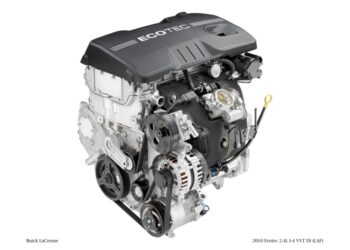Ford Explorer transmission solenoid problems can cause delayed shifting, gear skipping, and engine revving issues. Addressing these solenoid issues promptly can prevent further transmission damage and costly repairs.
If you’re experiencing symptoms such as sluggishness or warning lights, it’s crucial to seek professional assistance or follow DIY replacement guides available online. By taking proactive steps to resolve transmission solenoid problems, you can ensure smooth driving experiences and avoid potential breakdowns on the road.
Remember, addressing transmission solenoid issues promptly can save you time, money, and hassle in the long run.

Credit: www.justanswer.com
Identifying Transmission Solenoid Issues
Transmission solenoids play a crucial role in the operation of your Ford Explorer’s transmission system. Identifying issues with these solenoids is essential for maintaining the performance and longevity of your vehicle. In this section, we will discuss the common symptoms of solenoid failure and the diagnostic steps to pinpoint and address these issues effectively.
Common Symptoms Of Failure
- Delayed or unpredictable gear shifting
- Skipping gears
- Getting stuck in certain gears
- Vehicle sluggishness
- Inability to downshift/upshift
- Check Engine light/transmission warning light
- Engine continues to rev when applying the brakes
Diagnostic Steps
When faced with potential transmission solenoid problems, it’s important to take the following diagnostic steps to accurately identify the issue:
- Perform a comprehensive visual inspection of the transmission system, looking for any signs of damage or wear.
- Utilize diagnostic tools to conduct a thorough scan of the vehicle’s onboard computer system to retrieve any error codes related to the transmission solenoids.
- Test the transmission solenoids using specialized equipment to assess their functionality and responsiveness.
- Inspect the transmission fluid for any irregularities, such as contamination or unusual odors, which could indicate potential solenoid issues.
- Consult with a qualified mechanic or automotive technician to interpret diagnostic findings and determine the appropriate course of action for resolving the identified solenoid problems.
By recognizing these symptoms and following the outlined diagnostic steps, you can effectively address transmission solenoid issues in your Ford Explorer, ensuring optimal performance and reliability for your vehicle.
Safety And Driving
When it comes to your safety and the performance of your vehicle, it’s crucial to address any issues related to the transmission solenoid. Ignoring problems with the solenoid can lead to safety risks and impact the overall driving experience. Let’s explore the potential risks of driving with a bad solenoid and its impact on vehicle performance.
Risks Of Driving With A Bad Solenoid
Driving with a malfunctioning transmission solenoid can pose significant risks. Delayed or unpredictable gear shifting can result in hazardous driving conditions, potentially leading to accidents. Furthermore, skipping gears and getting stuck in certain gears can compromise the vehicle’s stability and control, posing a danger to both the driver and other road users.
Impact On Vehicle Performance
A bad solenoid can significantly affect the performance of your vehicle. Vehicle sluggishness and the inability to downshift or upshift can lead to poor acceleration and reduced responsiveness, impacting the overall driving experience. Additionally, the presence of Check Engine light or transmission warning light can indicate potential transmission issues, prompting the need for immediate attention to avoid further damage.
Transmission Solenoid Function
The function of a transmission solenoid in Ford Explorer can lead to various problems. Symptoms include delayed gear shifting, getting stuck in gears, and engine revving issues. It’s crucial to address these issues promptly to prevent further transmission damage and costly repairs.
Role In Gear Shifting
The transmission solenoid is a crucial component of an automatic transmission system. It controls the flow of transmission fluid to engage and disengage different gears. When the solenoid receives an electrical signal from the transmission control module, it opens a valve to allow the fluid to flow into the appropriate gear. This process enables the vehicle to shift gears smoothly without any input from the driver.Electrical And Mechanical Operations
The transmission solenoid operates based on both electrical and mechanical processes. When the solenoid receives an electrical signal, it creates a magnetic field that moves a plunger inside the valve body. This movement opens or closes the valve, allowing the transmission fluid to flow. The solenoid also has a mechanical function in controlling the movement of the plunger and valve. In addition, the transmission solenoid works in conjunction with other components of the transmission system, such as the torque converter and transmission control module, to ensure seamless gear shifting. However, when the solenoid malfunctions, it can cause a variety of transmission problems. Common symptoms of a faulty transmission solenoid include delayed or unpredictable gear shifting, skipping gears, getting stuck in certain gears, vehicle sluggishness, inability to downshift/upshift, check engine light/transmission warning light, and engine continuing to rev when applying the brakes. If you suspect a transmission solenoid problem, it is crucial to address it promptly to prevent further damage to the transmission system. While it is possible to drive with a malfunctioning transmission solenoid, it is not recommended as it can lead to costly repairs. In most cases, replacing the faulty solenoid is the only repair option. In conclusion, the transmission solenoid plays a crucial role in the proper functioning of an automatic transmission system. It is responsible for controlling the flow of transmission fluid to engage and disengage different gears. Therefore, it is essential to keep this component in good condition to ensure seamless gear shifting and prevent transmission problems.Diy Quick Fixes
If you’re experiencing transmission solenoid problems in your Ford Explorer, there are a few DIY quick fixes that you can try before seeking professional help. These fixes can help you address common issues related to the transmission solenoid and potentially save you time and money.
Resetting The Pcm
If you suspect that the transmission solenoid problems are caused by a communication error, resetting the Powertrain Control Module (PCM) can be a simple and effective solution. To reset the PCM, follow these steps:
- Turn off the ignition and wait for at least 10 seconds.
- Disconnect the negative terminal of the car battery.
- Wait for 15 minutes before reconnecting the negative terminal.
- Start the vehicle and check if the transmission performance has improved.
Solenoid Pack Electrical Harness
Issues with the electrical harness connected to the solenoid pack can also cause transmission problems. To address this, you can inspect the electrical harness for any signs of damage or corrosion. If you notice any issues, you can attempt to repair or replace the harness with the following steps:
- Locate the solenoid pack electrical harness attached to the transmission.
- Carefully inspect the harness for any visible damage or corrosion.
- If there are signs of damage, consider repairing or replacing the harness with a new one.
- After replacing the harness, test the transmission to see if the issue has been resolved.
Professional Repair Or Diy
When facing Ford Explorer transmission solenoid problems, the decision between seeking professional repair or opting for a do-it-yourself (DIY) approach is crucial. Understanding the complexities involved and the potential risks associated with each option is essential to ensure the proper functioning of your vehicle.
When To Seek Professional Help
If you lack the necessary technical expertise or access to specialized tools and diagnostic equipment, seeking professional help for Ford Explorer transmission solenoid problems is advisable. Professional technicians possess the knowledge and experience to accurately diagnose and effectively resolve complex transmission issues, ensuring the longevity and performance of your vehicle.
Tools Required For Diy
For those considering a DIY approach, it’s imperative to have the right tools and resources at your disposal. Below is a list of essential tools required for DIY transmission solenoid repair:
- Transmission fluid
- Socket set
- Ratchet and extension
- Jack and jack stands
- Replacement solenoid pack
- Diagnostic scanner
- Transmission filter and gasket kit
It’s important to note that attempting a DIY repair without the requisite tools and knowledge can lead to further damage and costly repairs. Proceed with caution and ensure you are well-equipped to handle the task at hand.
Solenoid Replacement Process
Replace your Ford Explorer’s transmission solenoid by following a DIY process. Watch online tutorials for step-by-step guidance. Fix issues like delayed gear shifting and prevent costly repairs.
Step-by-step Guide For Solenoid Replacement Process
If you’re experiencing symptoms of a bad transmission solenoid on your Ford Explorer, such as delayed or unpredictable gear shifting, getting stuck in certain gears, or a check engine/transmission warning light, it’s time to replace the solenoid. Here’s a step-by-step guide to help you replace the solenoid:Unplug Solenoid Pack Electrical Harness
The first step is to locate the solenoid pack, which is usually located on the side of the transmission. Once you’ve located it, unplug the electrical harness that connects the solenoid pack to the transmission.Solenoid Pack Removal
Next, remove the bolts that hold the solenoid pack in place using a socket wrench. Carefully remove the solenoid pack from the transmission, taking care not to damage any of the surrounding components.Solenoid Pack Replacement
Once you’ve removed the old solenoid pack, it’s time to install the new one. Carefully align the new solenoid pack with the transmission and secure it in place with the bolts you removed earlier.Replacing Transmission Filter
Before you reinstall the transmission pan, it’s a good idea to replace the transmission filter. This will help ensure that the transmission fluid stays clean and free of debris, which can cause further damage to your transmission.Install Transmission Pan Gasket
Once you’ve replaced the transmission filter, it’s time to install the transmission pan gasket. Make sure the gasket is properly aligned with the transmission pan before you reinstall it.Transmission Fill
After you’ve reinstalled the transmission pan, it’s time to refill the transmission with fresh fluid. Be sure to use the recommended type of transmission fluid for your Ford Explorer and check the fluid level with the dipstick to ensure that it’s at the correct level.Clear Pcm Memory
Finally, clear the PCM memory to ensure that the new solenoid pack is properly calibrated with your vehicle’s computer. You can do this by disconnecting the negative battery cable for a few minutes and then reconnecting it. Replacing a transmission solenoid on your Ford Explorer can be a bit tricky, but with this step-by-step guide, you should be able to do it yourself. If you’re not comfortable working on your vehicle, it’s always a good idea to take it to a professional mechanic for repairs.Post-repair Actions
After addressing the transmission solenoid problems in your Ford Explorer, there are crucial post-repair actions to ensure optimal performance. Here are the essential steps to take:
Transmission Pan Gasket Installation
When replacing the transmission solenoids, it’s essential to install a new transmission pan gasket. This helps to prevent leaks and ensures a secure seal for the transmission system. The gasket should be carefully aligned and firmly secured to avoid any potential leaks.
Refilling The Transmission Fluid
After installing the new transmission pan gasket, it’s imperative to refill the transmission fluid to the appropriate level. Use the recommended transmission fluid for your Ford Explorer and follow the manufacturer’s guidelines for the correct fluid level. Overfilling or underfilling the transmission fluid can lead to performance issues.

Credit: www.ebay.com
Long-term Care And Maintenance
Proper maintenance is crucial for ensuring the longevity and optimal performance of your Ford Explorer’s transmission system. By implementing a comprehensive long-term care plan, you can mitigate the risk of transmission solenoid problems and extend the lifespan of your vehicle.
Regular Inspection Intervals
Regular inspections of your Ford Explorer’s transmission system are essential to detect potential issues early on. Scheduled inspection intervals allow you to identify any signs of wear and tear, fluid leaks, or irregularities in the transmission solenoid operation. By adhering to a proactive inspection schedule, you can address any emerging problems promptly, preventing them from escalating into major transmission issues.
Transmission Adaptive Learning
The transmission adaptive learning process is a critical aspect of maintaining the efficiency of the solenoid system. This adaptive learning mechanism enables the transmission to adjust and optimize its performance based on driving patterns and environmental factors. By allowing the system to adapt to varying driving conditions, you can enhance the responsiveness and overall functionality of the transmission solenoids.
Cost Considerations
When dealing with Ford Explorer transmission solenoid problems, one crucial aspect to consider is the cost involved in repairing these issues. Understanding the Estimating Repair Expenses and comparing the DIY vs. Professional Costs can help you make an informed decision.
Estimating Repair Expenses
Repairing transmission solenoid problems in a Ford Explorer can vary in cost depending on the extent of the damage and the specific parts that need replacement. Below is an estimated breakdown of potential expenses:
| Expense | Cost Range |
|---|---|
| Transmission Solenoid Replacement Kit | $150 – $400 |
| Labor Costs | $200 – $500 |
| Total Repair Cost | $350 – $900 |
Comparing Diy Vs. Professional Costs
When considering the cost of repairing transmission solenoid problems, it’s essential to weigh the expenses associated with a DIY approach versus hiring a professional mechanic:
- DIY Costs: If you have the necessary skills and tools, opting for a DIY repair can save you money on labor costs.
- Professional Costs: While professional repairs may be more costly, they offer expertise and assurance of a proper fix.
Ultimately, the decision between DIY and professional repairs will depend on your comfort level with automotive work and budget constraints.

Credit: www.youtube.com
Troubleshooting After Repairs
After addressing Ford Explorer transmission solenoid problems, it’s crucial to troubleshoot for any residual issues and ensure proper functionality.
Addressing Residual Issues
- Check for any lingering transmission warning lights.
- Test drive the vehicle to assess gear shifting performance.
- Monitor for any unusual noises or vibrations.
Ensuring Proper Functionality
- Perform a comprehensive transmission fluid check.
- Verify the solenoid pack installation for proper alignment.
- Conduct a final diagnostic scan to confirm error code absence.
Understanding Solenoid Failure Causes
Solenoid problems in Ford Explorer transmissions can be attributed to various factors. One crucial aspect to consider is Understanding Solenoid Failure Causes. By identifying the root issues behind solenoid failures, you can take proactive steps to address and prevent these issues.
Mechanical Wear And Tear
Mechanical wear and tear is a common cause of solenoid failures in Ford Explorer transmissions. Over time, the constant movement and friction within the transmission system can lead to mechanical wear and tear on the solenoids. This wear can result in malfunctions and eventual failure of the solenoid components.
Electrical Faults
Electrical faults are another significant factor contributing to solenoid problems in Ford Explorer transmissions. Issues such as short circuits, voltage spikes, or corroded wiring can disrupt the electrical signals controlling the solenoids, leading to malfunction and failure.
Preventive Measures
Preventing Ford Explorer transmission solenoid problems is crucial for maintaining smooth vehicle operation. By taking specific preventive measures, you can avoid costly repairs and ensure your vehicle’s longevity.
Driving Habits To Avoid
- Avoid sudden acceleration or abrupt braking to reduce stress on the transmission system.
- Do not overload the vehicle as it can strain the transmission and lead to solenoid issues.
- Use the appropriate gear for the driving conditions to prevent unnecessary strain on the transmission.
Regular Vehicle Check-ups
- Schedule routine maintenance checks to identify any early signs of transmission solenoid problems.
- Monitor transmission fluid levels and ensure they are at the correct level for optimal performance.
- Inspect the transmission system for leaks or unusual sounds that could indicate solenoid issues.
Frequently Asked Questions
What Are The Symptoms Of A Transmission Solenoid Going Out?
Symptoms of a failing transmission solenoid include delayed or erratic gear shifts, skipping gears, and getting stuck in certain gears. Other signs are sluggishness, difficulty downshifting or upshifting, and illuminated check engine or transmission warning lights. Driving with a bad solenoid can further damage the transmission.
Can I Drive With A Bad Transmission Control Solenoid?
Driving with a bad transmission control solenoid is not recommended. While it’s possible, it can lead to further transmission damage and costly repairs.
Can You Replace Just A Solenoid On A Transmission?
Yes, if a transmission shift solenoid has failed, it can be replaced individually. Most auto repair shops, dealership service centers, or even DIYers can replace a transmission shift solenoid. However, it is essential to diagnose the issue correctly before replacing any parts to avoid unnecessary expenses.
Is A Transmission Solenoid Expensive To Fix?
Fixing a transmission solenoid can be expensive due to parts and labor costs. Driving with a bad solenoid can cause further transmission damage, leading to even costlier repairs.
What Are The Symptoms Of A Failing Transmission Solenoid?
Common signs include delayed shifting, gear skipping, vehicle sluggishness, warning lights, and revving when braking.
Conclusion
Addressing Ford Explorer transmission solenoid issues promptly is crucial to prevent further damage. The symptoms of solenoid problems can vary, affecting gear shifting and overall performance. While driving with a faulty solenoid is possible, it’s advisable to seek timely repairs to avoid costly transmission damage.

















